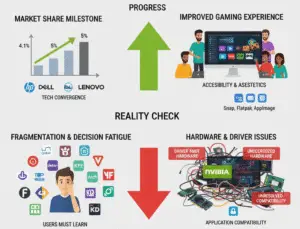
8 AI and Machine Learning Trends to Watch in 2025
AI is moving fast – here’s what’s changing and how it affects businesses like yours.
The excitement around artificial intelligence hasn’t faded, but it has matured. While early days were filled with hype, 2025 is shaping up to be a year of practical applications, real-world results, and smarter decision-making.
Let’s explore 8 of the biggest AI and machine learning trends expected to make a major impact in 2025.
1. The Hype Is Over – It’s Time for Results
Since 2022, everyone has been talking about generative AI, such as ChatGPT and Claude. But many businesses are still stuck in pilot mode. A lot of companies are experimenting, but few are fully integrating AI into their daily operations.

The reality? Managers aren’t always sure where AI is most useful. In some roles, AI helps a lot. In others, it can slow things down.
👉 In 2025, companies will demand clear results: cost savings, time efficiency, and better return on investment.
2. Generative AI Isn’t Just About Chatbots Anymore
 Image source: LeewayHertz
Image source: LeewayHertz
AI is moving beyond chat-based interfaces. While tools like ChatGPT are still popular, businesses are now building software that uses AI in the background — like summarizing documents or analyzing customer data.
We’re also seeing the rise of multimodal models. These AIs don’t just understand text — they can analyze images, video, and audio too. Examples include OpenAI’s Sora (text-to-video) and ElevenLabs (AI voice generation).
3. Say Hello to AI Agents
2025 is expected to be a breakout year for AI agents. Unlike chatbots that respond to prompts, AI agents can take action — like scheduling meetings, generating reports, or completing workflows.
Tools like Salesforce Agentforce are early examples.

But with autonomy comes risk. What if the agent makes a mistake? That’s why human oversight will still be critical, especially for sensitive tasks.
4. Foundation Models Are Becoming Commodities
There was a time when the race was all about building the “best” large language model. Now, most big models perform well enough for everyday use.
The real competitive edge lies in:
User-friendly tools
Lower costs
Seamless integration into business systems

It’s not just about how smart your AI is — it’s about how easily people can use it.
5. Domain-Specific AI Is the Future
Businesses are shifting from one-size-fits-all AI to tailored models for specific industries or tasks.
Whether it’s a hospital analyzing patient data or a factory automating quality checks, specialized models are more efficient — and often safer.

Also, bigger data doesn’t always mean better performance. Researchers now say “smarter” data, not “more” data, is what counts.
6. Everyone Needs Basic AI Literacy
You don’t have to be a programmer to use AI. But in 2025, everyone — from office staff to managers — will need basic AI literacy:
How to use AI tools
How to question results
When not to trust the output

Most workers are already using AI informally, like drafting emails or finding how-tos. Companies and schools are stepping in to provide real-time learning without going back to college.
7. AI Regulations Are Coming (Slowly)
In 2024, the EU passed the AI Act. In contrast, the U.S. is still mostly hands-off.
![]() Image source: Endpoint Protector
Image source: Endpoint Protector
That means businesses operating globally will likely default to the strictest standard — just like they did with GDPR.
A smart approach? Tiered regulation based on risk:
Low-risk AI (like chatbots) goes to market fast
High-risk AI (like medical diagnosis tools) faces more scrutiny
8. Security Risks Are Growing with AI
AI is a double-edged sword. It can boost productivity — but it also helps hackers.
In 2025, expect more AI-generated:
Phishing emails
Fake audio calls

Some scams even trick employees into wiring millions to fake accounts. Beyond scams, hackers may try to poison training data or exploit model weaknesses.
🛡️ Companies will need to include AI in their cybersecurity planning, not treat it as a side concern.
Final Thoughts: AI in 2025 Will Be Smarter – and So Will You
AI is evolving fast. In 2025, the winners won’t just be those with the best tools, but those who know how to use them well, secure them properly, and focus on outcomes — not just innovation.
Whether you’re a business leader, tech enthusiast, or just curious, now is the time to stay informed and ready.




